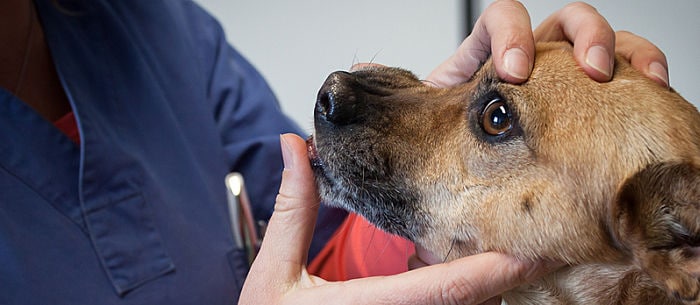You know when your teeth feel grungy. Even though you may be tired, you whip out your toothbrush for a few minutes, twice a day. But do you do the same for your dog?
Proper — and regular — dog teeth cleaning is essential for your dog, especially when it comes to preventing gum disease, also known as periodontal disease. As with humans, effective dog teeth cleaning involves professional help. But you also need to regularly brush your dog’s teeth at home.
“There is really no good substitute for daily brushing,” says Dr. Wendy Mandese, a clinical assistant professor at the University of Florida College of Veterinary Medicine who specializes in primary care and dentistry of small animals. “We recommend that commercial dental products be used in conjunction with brushing — not in place of brushing — unless brushing your pet’s teeth is not something that is possible.”
Of course, your veterinarian can periodically do prophylactic cleanings, which Dr. Erin Redeker-Goelitz, a veterinarian at Spring Hill Veterinary Clinic in Carpentersville, a suburb of Chicago, calls the best form of dental cleaning. “The dogs are anesthetized, and the teeth are scaled with an ultrasonic scaler and then polished,” she says, equating it to a person’s dental visit. But you still need to help keep your dog’s teeth clean in between visits. Here’s how to proceed.
How to Brush Your Dog’s Teeth
Here’s a step-by-step guide to setting up a great canine teeth cleaning regimen for your dog at home:
- Make It Routine
Set aside time each day to brush your dog’s teeth. Build it into your routine. Make it a habit as soon as possible. “It is important to start brushing your dog’s teeth when they are very young, even before they’ve lost their puppy teeth,” Dr. Mandese stresses.
- Get Your Gear
Choose a toothbrush with soft bristles and an angle that will allow you easy access to the back teeth. A children’s soft toothbrush or a finger toothbrush will also work. If your dog refuses a toothbrush, Mandese suggests using gauze wrapped around your finger.
- Get Your Dog Used to Your Touching His Teeth
Start by letting your pooch lick your fingers, as recommended by the American Society for the Prevention of Cruelty to Animals. Carefully move your fingers around the dog’s teeth until he’s accustomed to having that area handled.
- Brush the Side Teeth
Concentrate first on brushing the side teeth located under the upper lip.
- Brush the Outer Surfaces
The entire outer surface of the tooth should be cleaned with a special focus on the gum line. Experienced dog owners Katherine and Peter Sopkovich, who live in suburban Chicago, say they use a circular motion with a toothbrush on Samson, their 6-year-old gray Labradoodle. “We honestly don’t do it enough,” says Kathy Sopkovich, “but we try!”
- Brush the Inner Surface, If You Can
Try your best to get at the inside of your pooch’s teeth. If you find it impossible, Dr. Mandese advises that you concentrate on the buccal surface, or the part of the tooth that faces the outside of the mouth, which is often where the most tartar (also called calculus), or hardened dental plaque, forms.
When To Get to the Vet
In addition to cleaning your dog’s teeth at home or having the groomer add it on as a service, Dr. Mandese recommends that your dog’s teeth be evaluated by a vet at least once year — or more if your pooch has a history of dental disease. If you’re cleaning your dog’s teeth and see yellow and brown discoloration on a tooth’s surface, it signifies hardened plaque and you should bring your pet to the vet, says Dr. Mandese. Other signs to watch for are smelly breath, abnormal (slower) eating, bleeding gums and pawing at the mouth, which could be signs of periodontal disease.
Dog Teeth Cleaning Products
Here are some recommendations:
- Toothbrush
The Nylabone Advanced Oral Care Dog Finger Brush, which sells for $4.59 for a pack of two on Amazon, is designed to fit around your fingers.
- Toothpaste
Find one that is pleasing to your pet. The Virbac C.E.T. Enzymatic Toothpaste for Dogs and Cats comes in poultry, meat, beef, seafood, malt and vanilla-mint flavors.
- Dental Wipes
A canister of D.D.S. Dental Wipes (90-count) runs $6.38 on Amazon.
- Dental Chews
Try Milk-Bone Brushing Chews Daily Dental Treats or Canine Dental Chews by Greenies.
- Dental Diet Dog Food
Try a food designed to help teeth, such as Hill’s Science Diet Adult Oral Care food.
- Water Additive
Two teaspoons of C.E.T. Aquadent Drinking Water Additive by Virbac added daily to your pet’s drinking water can help maintain oral health and freshen breath.
To prevent tooth fracture and wear, Dr. Mandese says dogs should only be allowed to chew on dental-approved toys and chews, particularly those approved by the Veterinary Oral Health Council. Avoid giving them hard bones or tennis balls to nosh on.
And check out How to Clip Dog Nails.
Erin Chan Ding is a freelance journalist based in the Chicago area who writes about news, features, business, parenting, travel and pets.




